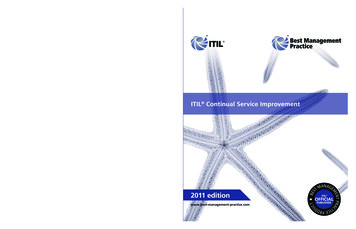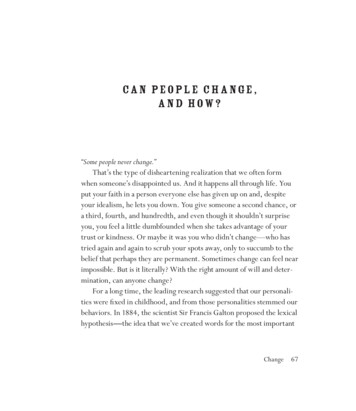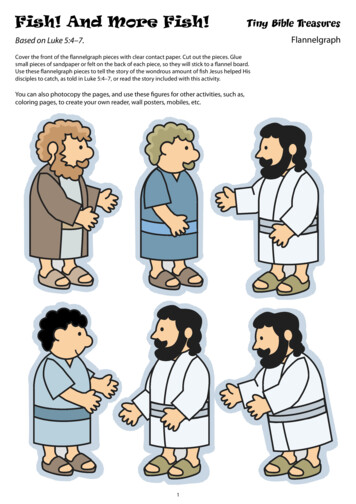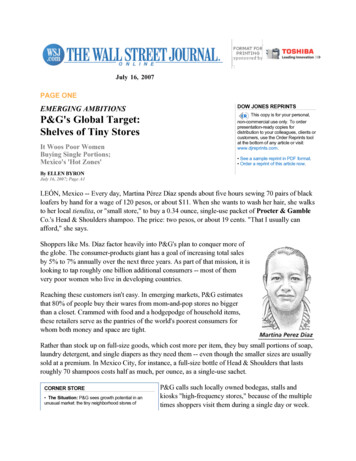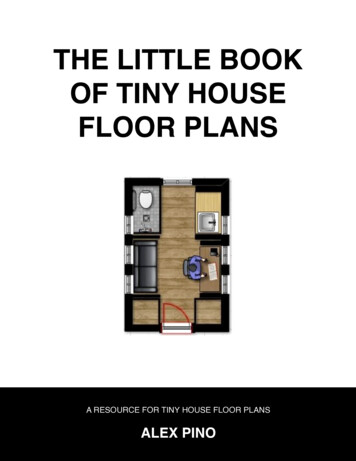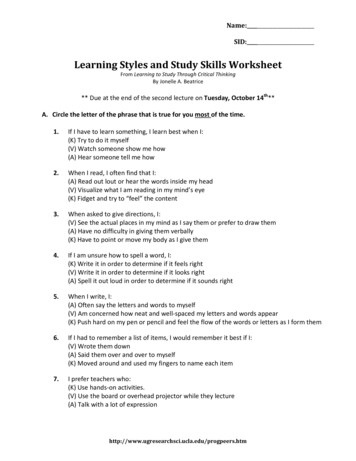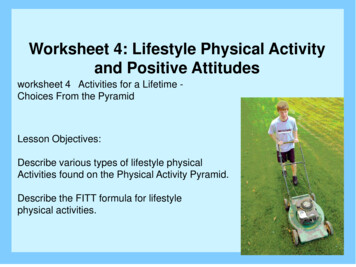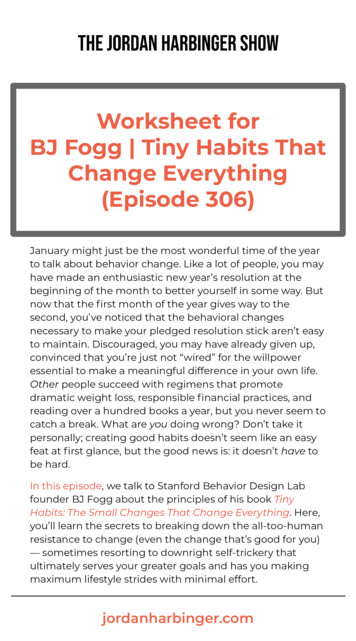
Transcription
Worksheet forBJ Fogg Tiny Habits ThatChange Everything(Episode 306)January might just be the most wonderful time of the yearto talk about behavior change. Like a lot of people, you mayhave made an enthusiastic new year’s resolution at thebeginning of the month to better yourself in some way. Butnow that the first month of the year gives way to thesecond, you’ve noticed that the behavioral changesnecessary to make your pledged resolution stick aren’t easyto maintain. Discouraged, you may have already given up,convinced that you’re just not “wired” for the willpoweressential to make a meaningful difference in your own life.Other people succeed with regimens that promotedramatic weight loss, responsible financial practices, andreading over a hundred books a year, but you never seem tocatch a break. What are you doing wrong? Don’t take itpersonally; creating good habits doesn’t seem like an easyfeat at first glance, but the good news is: it doesn’t have tobe hard.In this episode, we talk to Stanford Behavior Design Labfounder BJ Fogg about the principles of his book TinyHabits: The Small Changes That Change Everything. Here,you’ll learn the secrets to breaking down the all-too-humanresistance to change (even the change that’s good for you)— sometimes resorting to downright self-trickery thatultimately serves your greater goals and has you makingmaximum lifestyle strides with minimal effort.jordanharbinger.com
Why Behavior Change is HardWhy is behavior change so hard? BJ shares a couple ofthe biggest reasons:1.2.We believe the hype. “Forget everything you’veheard about behavior change and habits [fromnews headlines and social media] and start over,”he says. “So much is either distracting or justtaking you down the wrong path.”We try to motivate ourselves around anabstraction. “People pick an abstraction like, ‘Oh,I want to be more productive.’ It’s not specific,”says BJ. “And they try to motivate themselves tothe abstraction — that combo does not work. Ourmotivation goes up and down over time and wedon’t have a ton of control over that.”What are some changes you’ve had a difficult (orimpossible) time making in your own behavior? Arethey tied in to one of these two reasons, or do youidentify something else as the source of trouble?jordanharbinger.com
B MAP Fogg Behavior ModelIn the Fogg Behavior Model shown here, a Behavior isbrought about by a sufficient convergence of Motivation,Ability, and Prompts. B MAP."When it comes to behavior, there are threecomponents, and motivation and ability are two ofthem," says BJ. "What that curved line shows is they havea compensatory relationship. If your ability is weak -- ifthe behavior is hard to do -- then the motivation has tobe high or you won't be above the line. So if it's really,really easy to do, then I don't need lots of motivation forit to happen. I just need a prompt."When he first uncovered this model in 2007, BJwondered if B MAP could really be such a simpleformula that governs all behavior universally, and he’ssince concluded that, indeed, it does.jordanharbinger.com
This model shows that:1.2.3.4.The more motivated you are to do a behavior, themore likely you are to do a behavior.The harder a behavior is to do, the less likely youare to do it.Motivation and ability work together liketeammates.No behavior happens without a prompt.In action, it can look like this: Behavior (B): You take out the garbage as aresult of the following.Motivation (M): You want your spouse to stopnagging you and for your house to stop smellinglike garbage.Ability (A): It’s easy to tie the bag closed and walkit 10 steps to your garbage can in the backyard.Prompt (P): You were prompted by your spouse’sgentle reminder (and perhaps your nose).What behaviors in your own life can you dissect andunderstand by using this formula?jordanharbinger.com
Starter StepsWhen I lived in Michigan, I made the genius decision totrain for a 5k run in the middle of winter. Of course,about half the time I meant to go on my daily run, I’dwake up in my dorm room, freezing cold, and just goback to sleep. But when I resolved to allow myself to goback to bed only after I made the effort to put on mygym clothes and step outside, I found that I would —more often than not — just follow through and go for myrun. BJ calls this a starter step.“Some people report that they trick themselves withstarter steps,” says BJ. “Surprisingly, often people go allthe way. And that’s the magic. With starter steps, youovercome your initial resistance, and once you’re startedon the path, you just keep going. For example, openingyour sketchbook is a starter step in drawing a picture.Putting on your gym clothes is a starter step for workingout. Setting an apple on the kitchen counter is a starterstep for eating it.”What starter steps can you incorporate into thesometimes-unpleasant routines you often talkyourself out of that might prove similarly effective in“tricking” you into compliance?jordanharbinger.com
Tiny HabitsThe thought of flossing your teeth twice or doing 200pushups daily might seem daunting, but what if youstarted by only flossing one tooth and doing twopushups on day one, increasing it to two teeth and threepushups on day two, and so on? Even these tiny habitsthat lead to big changes don’t have to be done in lumpsums, as BJ demonstrates.“The pushups that I do, I do them throughout the day,”he says. “I do anywhere from two, which is the tinyversion, up to 25 or 30 if I want to push, but then I do itthrough the day. So that adds up. Flossing, I do twice aday. All my teeth. My hygienist loves me. My dentistcomes in and I’m like, the star patient! What I learned intweaking my own eating behavior was a whole banana isactually too much for me. My body doesn’t respond wellto that, so I snap it in half.”What big habits do you want to cultivate that can bewhittled down into tiny habits stretched out over thecourse of a day?jordanharbinger.com
Emotion, Not RepetitionContrary to a bit of misinformation circulating online(thanks to popular misconception surrounding a 2009study), repetition is not what creates habits. BJ and hiscolleagues point toward emotion as the real catalyst thatmakes habits possible.BJ says: “You could run a headline like: ‘Spending time inthe gym will lead to fitness.’ Somebody will read theheadline, go hang out at the gym bar, and go, ‘Okay, I’mspending tons of time in the gym. I’m not getting fit.’ Soof course it’s not time in the gym, it’s what you do in thegym, right? In the same way, it’s not repetition, it’s theemotion you feel when you do that behavior that sendsa signal to your brain and goes, ‘Oh, my gosh, take noteof this and wire this in.’While it sounds like bad news that you can’tmagically create a new habit just because youdedicate yourself to suffering for 21 to 66 days, thegood news is you don’t have to procrastinate thecreation of habits you want in your life. The TinyHabits approach allows you to begin making adifference in your behavior today by building up yourconfidence and competence over time rather thanmaking you feel bad for not being quite there. BJ callsthe positive emotion that compels habit formationshine. How does emotion compare to repetition as acatalyst for changes you’ve succeeded in making?How about failures?jordanharbinger.com
Behaviors Travel in PacksBehavioral change has a snowball effect. If you succeedin making steps toward cultivating one desired habit,others are sure to follow. For instance, I started takinglong walks to help me lose weight. And when I’d comehome, I’d make healthier meal choices because I didn’tjust walk three hours so I could negate it by eating awhole pizza. I’d also listen to audiobooks on these longwalks, which quickly helped me pare down myever-growing reading list. Each successful changereinforced that I was a person capable of makingchange — generating that emotional shine crucial tohabit formation — and BJ confirms that this correlateswith his own findings.“My data shows that over 70 percent of people [who aresuccessful in making one change] report havingchanged other habits within five days. For better orworse, the behaviors — the changes that we make —seem to travel in packs. Start anywhere you want on thepath to change, and if there’s some behavior — likeeating kale or meditating — that you don’t want to doright now, don’t focus on that. But as things change inyour journey, there’ll be times when you start doing theother stuff naturally. So start where you want to start.”What adjacent habits might form if you couldsucceed in focusing on the creation of just one habit?jordanharbinger.com
3 Ways to Make Something Easier“When it comes to making things easier to do, you canchange the person, you can change the context, or youcan change the action,” says BJ. Let’s consider what canbe done to pursue a fitness-related habit.You can change the person by skilling up and becomingmore capable of the action. Maybe you can learn to cookmore healthy meals, meditate, or read more books andarticles related to what you’re trying to achieve.You can change the environment or context by makingthe tools and resources you need easier to reach. BJ setup a CrossFit gym 20 feet away from his office so he canalways put in a few minutes to work out.You can change the action by establishing hacks, startersteps, or tiny habits to make what you’re trying toachieve less overwhelming. On a busy day, maybe BJcan’t take precious minutes away from work to work out,but he can always spare the time to do two pushupsafter every bathroom break.In pursuit of your own habit, which of these threethings can you change to make it an easierachievement?jordanharbinger.com
Anchoring with PromptsWe know that certain things can trigger a relapse into abad behavior. If you’re an alcoholic, having just one drinkcould be a disaster. If you’re addicted to gambling, youshould probably stay away from casinos. In the B MAPFogg Behavior Model, these triggers would equate withprompts, and prompts can originate from you, yourenvironment, another person, or a tiny habit. Just astriggers act as prompts that guide you toward anundesirable behavior, prompts can act as anchors thattether you to a desired behavior.You can self-prompt. You can use your environment as aprompt by putting a Post-it Note to your alarm clock.You can ask another person to prompt you. Or you canuse your existing action to prompt you as part of youroverall routine — maybe flossing reminds you to brushyour teeth, which reminds you to start your coffeemaker, which reminds you to stretch.“You’re not relying on Post-it Notes or alarms or just yourmemory. You’re designing it into your routine, and I callit anchoring,” says BJ. “So you attach the new habit, youanchor it to something very firm in your life, whichshould be a routine you already do very reliably.”What prompts can you add as anchoring to analready reliable routine?jordanharbinger.com
Behavior Design Flow ChartThe power to design your own behavior is actually prettyeasy to summon if you use this flow chart from Tiny Habits.Are you feeling motivated enough to learn a new skill? Yes? Great — do it. And now go to the next question.No? Next question.Are you feeling motivated enough to find a tool orresource? Yes? Excellent, make it happen. And now go to thenext question.No? Next question.Can you scale back the behavior to make it tiny? Yes? Fantastic. You’re done. You can start practicingyour new habit.No? Next question.Can you find a starter step for your behavior? Yes? Great. Make the starter step your initial habit,then do more later when you feel like it.No? Uh-oh. If you said no to all of these questions,you might need to go back and match yourself witha different behavior from your Swarm of Behaviors.Give it a try! See for yourself. We’ve only touched on thebasics of Tiny Habits; there’s a lot more in the book. Andif you’re so inclined, be sure to download BJ’s guidanceon using Behavior Design for business here!Full show notes and resources for this episodecan be found here.jordanharbinger.com
AboutJoin us as we get deep into the untappedwisdom of the world's top performers —from legendary creators to intelligenceoperatives, iconoclastic writers to visionarychange-makers.We deconstruct the playbooks of the mostsuccessful people on earth — and learnnew strategies, perspectives, and insightsyou can't find anywhere else. Then, takethese valuable insights into your own lifeand live what you listen.jordanharbinger.com
support@jordanharbinger.comjordanharbinger.com
Share This WithYour Friends!jordanharbinger.com
Habits: The Small Changes That Change Everything. Here, you’ll learn the secrets to breaking down the all-too-human resistance to change (even the change that’s good for you) — sometimes resorting to downright self-trickery that ultimately serves your greater goals and has you making
